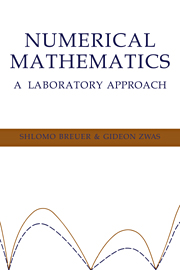Book contents
- Frontmatter
- Contents
- Preface
- Chapter 1 Mathematics in a numerical laboratory
- Chapter 2 Iterations for root extraction
- Chapter 3 Area approximations
- Chapter 4 Linear systems – An algorithmic approach
- Chapter 5 Algorithmic computations of π and e
- Chapter 6 Convergence acceleration
- Chapter 7 Interpolative approximation
- Chapter 8 Computer library functions
- Solutions to selected exercise
- Index
Chapter 1 - Mathematics in a numerical laboratory
Published online by Cambridge University Press: 05 June 2012
- Frontmatter
- Contents
- Preface
- Chapter 1 Mathematics in a numerical laboratory
- Chapter 2 Iterations for root extraction
- Chapter 3 Area approximations
- Chapter 4 Linear systems – An algorithmic approach
- Chapter 5 Algorithmic computations of π and e
- Chapter 6 Convergence acceleration
- Chapter 7 Interpolative approximation
- Chapter 8 Computer library functions
- Solutions to selected exercise
- Index
Summary
The mathematical laboratory
Accumulated experience has shown that early emphasis on algorithmic thinking, augmented by actual computing, is indispensable in mathematical education. Recognizing the cardinal importance of the individual, active involvement of every student in the computational work (as opposed to mere demonstration by the teacher), we advocate the use of mathematical laboratories equipped with microcomputers. Optimally, a special room should be set aside for the mathematical laboratory. Failing that, physics or biology laboratories can be used since they tend to create the proper atmosphere. A pair of students is assigned to each microcomputer, as to a microscope in a biology laboratory, and spends a few hours a week working with the microcomputer in the laboratory.
The mere presence of an increasing number of microcomputers in various educational institutions, even those at which a programming language such as True-Basic or Pascal is taught, in no way constitutes a new mode of teaching and learning. The full potential of microcomputers and proper courseware should be harnessed to improve the state of the art in education. Moreover, a new role will be played by the mathematics teacher when traditional “chalk-and-talk” methods are augmented by active participation as a laboratory instructor. The numerous advantages of such computer-aided teaching of mathematics are detailed in Section 1.2.
The laboratory work will center around specific assignments, or modules, to be carried out by the participants at their own pace.
- Type
- Chapter
- Information
- Numerical MathematicsA Laboratory Approach, pp. 1 - 11Publisher: Cambridge University PressPrint publication year: 1993



